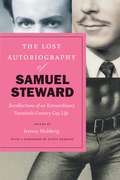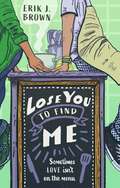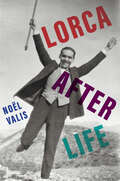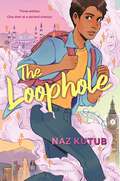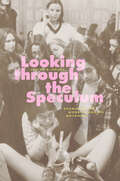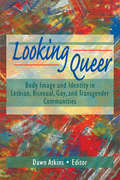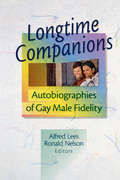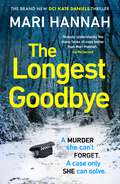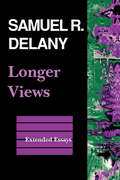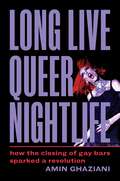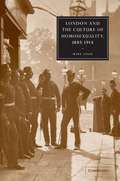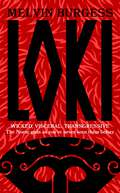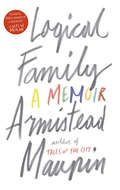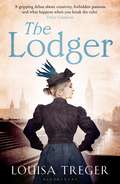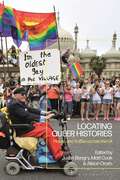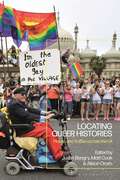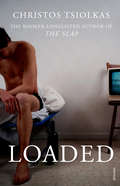- Table View
- List View
The Lost Autobiography of Samuel Steward: Recollections of an Extraordinary Twentieth-Century Gay Life
by Samuel StewardOn August 21, 1978, a year before his seventieth birthday, Samuel Steward (1909–93) sat down at his typewriter in Berkeley, California, and began to compose a remarkable autobiography. No one but his closest friends knew the many different identities he had performed during his life: as Samuel Steward, he had been a popular university professor of English; as Phil Sparrow, an accomplished tattoo artist; as Ward Stames, John McAndrews, and Donald Bishop, a prolific essayist in the first European gay magazines; as Phil Andros, the author of a series of popular pornographic gay novels during the 1960s and 1970s. Steward had also moved in the circles of Gertrude Stein, Thornton Wilder, and Alfred Kinsey, among many other notable figures of the twentieth century. And, as a compulsive record keeper, he had maintained a meticulous card-file index throughout his life that documented his 4,500 sexual encounters with more than 800 men. The story of this life would undoubtedly have been a sensation if it had reached publication. But after finishing a 110,000-word draft in 1979, Steward lost interest in the project and subsequently published only a slim volume of selections from his manuscript. In The Lost Autobiography of Samuel Steward, Jeremy Mulderig has integrated Steward’s truncated published text with the text of the original manuscript to create the first extended version of Steward’s autobiography to appear in print—the first sensational, fascinating, and ultimately enlightening story of his many lives told in his own words. The product of a rigorous line-by-line comparison of these two sources and a thoughtful editing of their contents, Mulderig’s thoroughly annotated text is more complete and coherent than either source alone while also remaining faithful to Steward’s style and voice, to his engaging self-deprecation and his droll sense of humor. Compellingly readable and often unexpectedly funny, this newly discovered story of a gay life full of wildly improbable—but nonetheless true—events is destined to become a landmark queer autobiography from the twentieth century.
The Lost Autobiography of Samuel Steward: Recollections of an Extraordinary Twentieth-Century Gay Life
by Samuel StewardOn August 21, 1978, a year before his seventieth birthday, Samuel Steward (1909–93) sat down at his typewriter in Berkeley, California, and began to compose a remarkable autobiography. No one but his closest friends knew the many different identities he had performed during his life: as Samuel Steward, he had been a popular university professor of English; as Phil Sparrow, an accomplished tattoo artist; as Ward Stames, John McAndrews, and Donald Bishop, a prolific essayist in the first European gay magazines; as Phil Andros, the author of a series of popular pornographic gay novels during the 1960s and 1970s. Steward had also moved in the circles of Gertrude Stein, Thornton Wilder, and Alfred Kinsey, among many other notable figures of the twentieth century. And, as a compulsive record keeper, he had maintained a meticulous card-file index throughout his life that documented his 4,500 sexual encounters with more than 800 men. The story of this life would undoubtedly have been a sensation if it had reached publication. But after finishing a 110,000-word draft in 1979, Steward lost interest in the project and subsequently published only a slim volume of selections from his manuscript. In The Lost Autobiography of Samuel Steward, Jeremy Mulderig has integrated Steward’s truncated published text with the text of the original manuscript to create the first extended version of Steward’s autobiography to appear in print—the first sensational, fascinating, and ultimately enlightening story of his many lives told in his own words. The product of a rigorous line-by-line comparison of these two sources and a thoughtful editing of their contents, Mulderig’s thoroughly annotated text is more complete and coherent than either source alone while also remaining faithful to Steward’s style and voice, to his engaging self-deprecation and his droll sense of humor. Compellingly readable and often unexpectedly funny, this newly discovered story of a gay life full of wildly improbable—but nonetheless true—events is destined to become a landmark queer autobiography from the twentieth century.
The Lost Autobiography of Samuel Steward: Recollections of an Extraordinary Twentieth-Century Gay Life
by Samuel StewardOn August 21, 1978, a year before his seventieth birthday, Samuel Steward (1909–93) sat down at his typewriter in Berkeley, California, and began to compose a remarkable autobiography. No one but his closest friends knew the many different identities he had performed during his life: as Samuel Steward, he had been a popular university professor of English; as Phil Sparrow, an accomplished tattoo artist; as Ward Stames, John McAndrews, and Donald Bishop, a prolific essayist in the first European gay magazines; as Phil Andros, the author of a series of popular pornographic gay novels during the 1960s and 1970s. Steward had also moved in the circles of Gertrude Stein, Thornton Wilder, and Alfred Kinsey, among many other notable figures of the twentieth century. And, as a compulsive record keeper, he had maintained a meticulous card-file index throughout his life that documented his 4,500 sexual encounters with more than 800 men. The story of this life would undoubtedly have been a sensation if it had reached publication. But after finishing a 110,000-word draft in 1979, Steward lost interest in the project and subsequently published only a slim volume of selections from his manuscript. In The Lost Autobiography of Samuel Steward, Jeremy Mulderig has integrated Steward’s truncated published text with the text of the original manuscript to create the first extended version of Steward’s autobiography to appear in print—the first sensational, fascinating, and ultimately enlightening story of his many lives told in his own words. The product of a rigorous line-by-line comparison of these two sources and a thoughtful editing of their contents, Mulderig’s thoroughly annotated text is more complete and coherent than either source alone while also remaining faithful to Steward’s style and voice, to his engaging self-deprecation and his droll sense of humor. Compellingly readable and often unexpectedly funny, this newly discovered story of a gay life full of wildly improbable—but nonetheless true—events is destined to become a landmark queer autobiography from the twentieth century.
The Lost Autobiography of Samuel Steward: Recollections of an Extraordinary Twentieth-Century Gay Life
by Samuel StewardOn August 21, 1978, a year before his seventieth birthday, Samuel Steward (1909–93) sat down at his typewriter in Berkeley, California, and began to compose a remarkable autobiography. No one but his closest friends knew the many different identities he had performed during his life: as Samuel Steward, he had been a popular university professor of English; as Phil Sparrow, an accomplished tattoo artist; as Ward Stames, John McAndrews, and Donald Bishop, a prolific essayist in the first European gay magazines; as Phil Andros, the author of a series of popular pornographic gay novels during the 1960s and 1970s. Steward had also moved in the circles of Gertrude Stein, Thornton Wilder, and Alfred Kinsey, among many other notable figures of the twentieth century. And, as a compulsive record keeper, he had maintained a meticulous card-file index throughout his life that documented his 4,500 sexual encounters with more than 800 men. The story of this life would undoubtedly have been a sensation if it had reached publication. But after finishing a 110,000-word draft in 1979, Steward lost interest in the project and subsequently published only a slim volume of selections from his manuscript. In The Lost Autobiography of Samuel Steward, Jeremy Mulderig has integrated Steward’s truncated published text with the text of the original manuscript to create the first extended version of Steward’s autobiography to appear in print—the first sensational, fascinating, and ultimately enlightening story of his many lives told in his own words. The product of a rigorous line-by-line comparison of these two sources and a thoughtful editing of their contents, Mulderig’s thoroughly annotated text is more complete and coherent than either source alone while also remaining faithful to Steward’s style and voice, to his engaging self-deprecation and his droll sense of humor. Compellingly readable and often unexpectedly funny, this newly discovered story of a gay life full of wildly improbable—but nonetheless true—events is destined to become a landmark queer autobiography from the twentieth century.
The Lost Autobiography of Samuel Steward: Recollections of an Extraordinary Twentieth-Century Gay Life
by Samuel StewardOn August 21, 1978, a year before his seventieth birthday, Samuel Steward (1909–93) sat down at his typewriter in Berkeley, California, and began to compose a remarkable autobiography. No one but his closest friends knew the many different identities he had performed during his life: as Samuel Steward, he had been a popular university professor of English; as Phil Sparrow, an accomplished tattoo artist; as Ward Stames, John McAndrews, and Donald Bishop, a prolific essayist in the first European gay magazines; as Phil Andros, the author of a series of popular pornographic gay novels during the 1960s and 1970s. Steward had also moved in the circles of Gertrude Stein, Thornton Wilder, and Alfred Kinsey, among many other notable figures of the twentieth century. And, as a compulsive record keeper, he had maintained a meticulous card-file index throughout his life that documented his 4,500 sexual encounters with more than 800 men. The story of this life would undoubtedly have been a sensation if it had reached publication. But after finishing a 110,000-word draft in 1979, Steward lost interest in the project and subsequently published only a slim volume of selections from his manuscript. In The Lost Autobiography of Samuel Steward, Jeremy Mulderig has integrated Steward’s truncated published text with the text of the original manuscript to create the first extended version of Steward’s autobiography to appear in print—the first sensational, fascinating, and ultimately enlightening story of his many lives told in his own words. The product of a rigorous line-by-line comparison of these two sources and a thoughtful editing of their contents, Mulderig’s thoroughly annotated text is more complete and coherent than either source alone while also remaining faithful to Steward’s style and voice, to his engaging self-deprecation and his droll sense of humor. Compellingly readable and often unexpectedly funny, this newly discovered story of a gay life full of wildly improbable—but nonetheless true—events is destined to become a landmark queer autobiography from the twentieth century.
Lose You to Find Me
by Erik J. BrownTommy Dees is in the weeds - restaurant speak for beyond overwhelmed. He's been working at Sunset Estates Retirement Community to get the experience he needs to attend one of the best culinary schools in the world. And he also needs a letter of recommendation from his sadistic manager. In exchange for the letter, Tommy has to meet three conditions - including train new-hire Gabriel.Gabe, with the dimples and kind heart, who Tommy crushed on during summer camp at age ten and then never saw again. Unfortunately, Gabe doesn't remember Tommy at all. The training proves distracting as old feelings resurface, and the universe seems to be conspiring against them.With the application deadline looming and Gabe on his mind, can Tommy keep it all together or is it a recipe for disaster?
Lorca After Life
by Noel ValisA reflection on Federico García Lorca’s life, his haunting death, and the fame that reinvigorated the marvelous in the modern world “A galaxy of critical insights into the cultural shock waves circling and crisscrossing Lorca’s execution and his unknown resting place, there is not a single book on Lorca like this one.”—Andrés Zamora, Vanderbilt University There is something fundamentally unfinished about the life and work of Federico García Lorca (1898–1936), and not simply because his life ended abruptly. Noël Valis reveals how this quality gives shape to the ways in which he has been continuously re-imagined since his death. Lorca’s execution at the start of the Spanish Civil War was not only horrific but transformative, setting in motion many of the poet’s afterlives. He is intimately tied to both an individual and a collective identity, as the people’s poet, a gay icon, and fabled member of a dead poets’ society. The specter of his violent death continues to haunt everything connected to Lorca, fueling the desire to fill in the gaps in the poet’s biography.
The Loophole
by Naz KutubA gay Muslim boy travels the world for a second chance at love after a possibly magical heiress grants him three wishes in this YA debut that's Simon vs. the Homo Sapiens Agenda with a twist of magic.Sy placed all his bets for happiness on his boyfriend, Farouk . . . who then left him to try and “fix the world.” Now, the timid seventeen-year-old Indian Muslim boy is stuck in a dead-end coffee shop job and all he can do is wish for one more chance . . . Sy never expects his wish to be granted. But when a mysterious girl offers him three wishes in exchange for his help and proves she can grant at least one wish with an instant million-dollar deposit into Sy's struggling bank account, a whole new world of possibility opens up. Is she magic? Or just rich? And can Sy find the courage to leave Los Angeles and cross the Atlantic Ocean to lands he'd never even dreamed he could visit, all to track down his missing ex? With help from his potentially otherworldly new friend, will Sy go all the way for one last, desperate chance at rebuilding his life and refinding love?Your wish is granted! Naz Kutub's debut weaves an engrossing whirlwind of an adventure with a journey to find love, home, and family.
Looking through the Speculum: Examining the Women’s Health Movement
by Judith A. HouckHighlights local history to tell a national story about the evolution of the women’s health movement, illuminating the struggles and successes of bringing feminist dreams into clinical spaces. The women’s health movement in the United States, beginning in 1969 and taking hold in the 1970s, was a broad-based movement seeking to increase women’s bodily knowledge, reproductive control, and well-being. It was a political movement that insisted that bodily autonomy provided the key to women’s liberation. It was also an institution-building movement that sought to transform women’s relationships with medicine; it was dedicated to increasing women’s access to affordable health care without the barriers of homophobia, racism, and sexism. But the movement did not only focus on women’s bodies. It also encouraged activists to reimagine their relationships with one another, to develop their relationships in the name of personal and political change, and, eventually, to discover and confront the limitations of the bonds of womanhood. This book examines historically the emergence, development, travails, and triumphs of the women’s health movement in the United States. By bringing medical history and the history of women’s bodies into our emerging understandings of second-wave feminism, the author sheds light on the understudied efforts to shape health care and reproductive control beyond the hospital and the doctor’s office—in the home, the women’s center, the church basement, the bookshop, and the clinic. Lesbians, straight women, and women of color all play crucial roles in this history. At its center are the politics, institutions, and relationships created by and within the women’s health movement, depicted primarily from the perspective of the activists who shaped its priorities, fought its battles, and grappled with its shortcomings.
Looking through the Speculum: Examining the Women’s Health Movement
by Judith A. HouckHighlights local history to tell a national story about the evolution of the women’s health movement, illuminating the struggles and successes of bringing feminist dreams into clinical spaces. The women’s health movement in the United States, beginning in 1969 and taking hold in the 1970s, was a broad-based movement seeking to increase women’s bodily knowledge, reproductive control, and well-being. It was a political movement that insisted that bodily autonomy provided the key to women’s liberation. It was also an institution-building movement that sought to transform women’s relationships with medicine; it was dedicated to increasing women’s access to affordable health care without the barriers of homophobia, racism, and sexism. But the movement did not only focus on women’s bodies. It also encouraged activists to reimagine their relationships with one another, to develop their relationships in the name of personal and political change, and, eventually, to discover and confront the limitations of the bonds of womanhood. This book examines historically the emergence, development, travails, and triumphs of the women’s health movement in the United States. By bringing medical history and the history of women’s bodies into our emerging understandings of second-wave feminism, the author sheds light on the understudied efforts to shape health care and reproductive control beyond the hospital and the doctor’s office—in the home, the women’s center, the church basement, the bookshop, and the clinic. Lesbians, straight women, and women of color all play crucial roles in this history. At its center are the politics, institutions, and relationships created by and within the women’s health movement, depicted primarily from the perspective of the activists who shaped its priorities, fought its battles, and grappled with its shortcomings.
Looking Queer: Body Image and Identity in Lesbian, Bisexual, Gay, and Transgender Communities
by Dawn AtkinsLooking Queer: Body Image in Lesbian, Bisexual, Gay, and Transgender Communities contains research, firsthand accounts, poetry, theory, and journalistic essays that address and outline the special needs of sexual minorities when dealing with eating disorders and appearance obsession. Looking Queer will give members of these communities hope, insight, and information into body image issues, helping you to accept and to love your body. In addition, scholars, health care professionals, and body image activists will not only learn about queer experiences and identity and how they affect individuals, but will also understand how some of the issues involved affect society as a whole. Dismantling the myth that body image issues affect only heterosexual women, Looking Queer explores body issues based on gender, race, class, age, and disability. Furthermore, this groundbreaking book attests to the struggles, pain, and triumph of queer people in an open and comprehensive manner. More than 60 contributors provide their knowledge and personal experiences in dealing with body image issues exclusive to the gay and transgender communities, including: exploring and breaking down the categories of gender and sexuality that are found in many body image issues finding ways to heal yourself and your community discovering what it means to “look like a dyke” or to “look gay” fearing fat as a sign of femininity determining what race has to do with the gay ideal discussing the stereotyped ”double negative”--being a fat lesbian learning strategies of resistance to societal ideals critiquing ”the culture of desire” within gay men’s communities that emphasizes looks above everything elseRevealing new and complex dimensions to body image issues, Looking Queer not only discusses the struggles and hardships of gay, lesbian, bisexual, and transgendered persons, but looks at the processes that can lead to acceptance of oneself. Written by both men and women, the topics and research in Looking Queer offer insight into the lives of people you can relate to, enabling you to learn from their experiences so you, too, can find joy and happiness in accepting your body.Visit Dawn Atkin’s website at: http://home.earthlink.net/~dawn_atkins/
Looking Queer: Body Image and Identity in Lesbian, Bisexual, Gay, and Transgender Communities
by Dawn AtkinsLooking Queer: Body Image in Lesbian, Bisexual, Gay, and Transgender Communities contains research, firsthand accounts, poetry, theory, and journalistic essays that address and outline the special needs of sexual minorities when dealing with eating disorders and appearance obsession. Looking Queer will give members of these communities hope, insight, and information into body image issues, helping you to accept and to love your body. In addition, scholars, health care professionals, and body image activists will not only learn about queer experiences and identity and how they affect individuals, but will also understand how some of the issues involved affect society as a whole. Dismantling the myth that body image issues affect only heterosexual women, Looking Queer explores body issues based on gender, race, class, age, and disability. Furthermore, this groundbreaking book attests to the struggles, pain, and triumph of queer people in an open and comprehensive manner. More than 60 contributors provide their knowledge and personal experiences in dealing with body image issues exclusive to the gay and transgender communities, including: exploring and breaking down the categories of gender and sexuality that are found in many body image issues finding ways to heal yourself and your community discovering what it means to “look like a dyke” or to “look gay” fearing fat as a sign of femininity determining what race has to do with the gay ideal discussing the stereotyped ”double negative”--being a fat lesbian learning strategies of resistance to societal ideals critiquing ”the culture of desire” within gay men’s communities that emphasizes looks above everything elseRevealing new and complex dimensions to body image issues, Looking Queer not only discusses the struggles and hardships of gay, lesbian, bisexual, and transgendered persons, but looks at the processes that can lead to acceptance of oneself. Written by both men and women, the topics and research in Looking Queer offer insight into the lives of people you can relate to, enabling you to learn from their experiences so you, too, can find joy and happiness in accepting your body.Visit Dawn Atkin’s website at: http://home.earthlink.net/~dawn_atkins/
Longtime Companions: Autobiographies of Gay Male Fidelity
by Alfred Lees Ronald NelsonLongtime Companions: Autobiographies of Gay Male Fidelity provides a sophisticated alternative to “anything goes” gay literature. Challenging the stereotype that gay men are incapable of lasting and successful relationships, 15 long-term gay couples share slices of their own lives to give you insight into their present relationships, while some discuss life after their mates have passed on. You will find that their stories offer an inspirational and richly fulfilling alternative to an empty life of promiscuity that lacks true love.Through a treasury of autobiographical essays, Longtime Companions documents how committed gay male unions can be as enduring, nurturing, and diverse as heterosexual marriages and proves that loving commitments and life-sharing are not exclusive to heterosexual unions. A celebration of gay diversity, this book offers you insights from contributors of different ages, professions, geographic locations, and attitudes. You will learn the intimate details of the couples’lives, including: how they met their partners how soon they committed to each other how long the couples have been together--from 14 years to over 50 years their keys to leading successful, happy lives the ways in which their relationships fulfill their personal needs and contribute to community lifeYou will come to realize the true strength of these men’s relationships as you share in their struggles within a society that offers them little recognition or support for their successful relationships. Co-editor Alfred Lees explains in the introduction to Longtime Companions, “We’ve all worked diligently to make our partnerships sound, nurturing, and enduring. We’ve done this without any social motivation, largely without role models, in the face of ‘official’disapproval or contempt. We’ve told our stories here to refute--by the simple facts of our experience--the grotesque misrepresentation of gays as being incapable of stable, committed relationships.” Will add more. . . Through a treasury of autobiographical essays, Longtime Companions documents how committed gay-male unions can be as enduring, nurturing, and diverse as heterosexual marriages and proves that loving commitment and life-sharing are not exclusive to heterosexual unions. A celebration of gay diversity, contributors vary in age, profession, geographic location, and attitudes. You will learn the intimate details of the couples’lives, including: how they met their partners how soon they committed to each other how they managed to collaborate on successful, fulfilling lives how some have maintained their commitment as part of an open relationshipYou will come to realize the true strength of these men’s relationships as you share in their struggles within a society that offers them little recognition or support for their successful relationships. Co-Author Alfred Lees explains in the Introduction to Longtime Companions, “We’ve all worked diligently to make our partnerships sound, nurturing, and enduring. We&’ve done this without any social innovation, largely without role models, in the face of ‘official” disapproval or contempt. We’ve told our stories here to refute--by the simple facts of our experience--the grotesque misrepresentation of gays as being incapable of stable, committed relationships.”
Longtime Companions: Autobiographies of Gay Male Fidelity
by Alfred Lees Ronald NelsonLongtime Companions: Autobiographies of Gay Male Fidelity provides a sophisticated alternative to “anything goes” gay literature. Challenging the stereotype that gay men are incapable of lasting and successful relationships, 15 long-term gay couples share slices of their own lives to give you insight into their present relationships, while some discuss life after their mates have passed on. You will find that their stories offer an inspirational and richly fulfilling alternative to an empty life of promiscuity that lacks true love.Through a treasury of autobiographical essays, Longtime Companions documents how committed gay male unions can be as enduring, nurturing, and diverse as heterosexual marriages and proves that loving commitments and life-sharing are not exclusive to heterosexual unions. A celebration of gay diversity, this book offers you insights from contributors of different ages, professions, geographic locations, and attitudes. You will learn the intimate details of the couples’lives, including: how they met their partners how soon they committed to each other how long the couples have been together--from 14 years to over 50 years their keys to leading successful, happy lives the ways in which their relationships fulfill their personal needs and contribute to community lifeYou will come to realize the true strength of these men’s relationships as you share in their struggles within a society that offers them little recognition or support for their successful relationships. Co-editor Alfred Lees explains in the introduction to Longtime Companions, “We’ve all worked diligently to make our partnerships sound, nurturing, and enduring. We’ve done this without any social motivation, largely without role models, in the face of ‘official’disapproval or contempt. We’ve told our stories here to refute--by the simple facts of our experience--the grotesque misrepresentation of gays as being incapable of stable, committed relationships.” Will add more. . . Through a treasury of autobiographical essays, Longtime Companions documents how committed gay-male unions can be as enduring, nurturing, and diverse as heterosexual marriages and proves that loving commitment and life-sharing are not exclusive to heterosexual unions. A celebration of gay diversity, contributors vary in age, profession, geographic location, and attitudes. You will learn the intimate details of the couples’lives, including: how they met their partners how soon they committed to each other how they managed to collaborate on successful, fulfilling lives how some have maintained their commitment as part of an open relationshipYou will come to realize the true strength of these men’s relationships as you share in their struggles within a society that offers them little recognition or support for their successful relationships. Co-Author Alfred Lees explains in the Introduction to Longtime Companions, “We’ve all worked diligently to make our partnerships sound, nurturing, and enduring. We&’ve done this without any social innovation, largely without role models, in the face of ‘official” disapproval or contempt. We’ve told our stories here to refute--by the simple facts of our experience--the grotesque misrepresentation of gays as being incapable of stable, committed relationships.”
The Longest Goodbye: The awardwinning author of WITHOUT A TRACE returns with her most heart-pounding crime thriller yet - DCI Kate Daniels 9 (Kate Daniels #3)
by Mari HannahLIES COST LIVESTHE BRAND NEW KATE DANIELS THRILLERThree years ago police officer Georgina Ioannau was murdered, her killers never brought to justice.Now the prime suspects have been shot dead within hours of their return to the UK.Has someone finally taken the law into their own hands?Seeking out the truth will force Kate Daniels to confront her own past mistakes, and put her career, and her team's lives, on the line.The gripping new Kate Daniels thriller about what happens when someone takes the law into their own hands from awardwinning crime writer Mari Hannah.
Longer Views: Extended Essays
by Samuel R. Delany"Reading is a many-layered process — like writing," observes Samuel R. Delany, a Nebula and Hugo award-winning author and a major commentator on American literature and culture. In this collection of six extended essays, Delany challenges what he calls "the hard-edged boundaries of meaning" by going beyond the customary limits of the genre in which he's writing. By radically reworking the essay form, Delany can explore and express the many layers of his thinking about the nature of art, the workings of language, and the injustices and ironies of social, political, and sexual marginalization. Thus Delany connects, in sometimes unexpected ways, topics as diverse as the origins of modern theater, the context of lesbian and gay scholarship, the theories of cyborgs, how metaphors mean, and the narrative structures in the Star Wars trilogy."Over the course of his career," Kenneth James writes in his extensive introduction, "Delany has again and again thrown into question the world-models that all too many of us unknowingly live by." Indeed, Delany challenges an impressive list of world-models here, including High and Low Art, sanity and madness, mathematical logic and the mechanics of mythmaking, the distribution of wealth in our society, and the limitations of our sexual vocabulary. Also included are two essays that illustrate Delany's unique chrestomathic technique, the grouping of textual fragments whose associative interrelationships a reader must actively trace to read them as a resonant argument. Whether writing about Wagner or Hart Crane, Foucault or Robert Mapplethorpe, Delany combines a fierce and often piercing vision with a powerful honesty that beckons us to share in the perspective of these Longer Views.
Long Live Queer Nightlife: How the Closing of Gay Bars Sparked a Revolution
by Amin GhazianiIt&’s closing time for an alarming number of gay bars in cities around the globe—but it&’s definitely not the last danceIn this exhilarating journey into underground parties, pulsating with life and limitless possibility, acclaimed author Amin Ghaziani unveils the unexpected revolution revitalizing urban nightlife.Far from the gay bar with its largely white, gay male clientele, here is a dazzling scene of secret parties—club nights—wherein culture creatives, many of whom are queer, trans, and racial minorities, reclaim the night in the name of those too long left out. Episodic, nomadic, and radically inclusive, club nights are refashioning queer nightlife in boundlessly imaginative and powerfully defiant ways.Drawing on Ghaziani&’s immersive encounters at underground parties in London and more than one hundred riveting interviews with everyone from bar owners to party producers, revelers to rabble-rousers, Long Live Queer Nightlife showcases a spectacular, if seldom-seen, vision of a queer world shimmering with self-empowerment, inventiveness, and joy.
Long Live Queer Nightlife: How the Closing of Gay Bars Sparked a Revolution
by Amin GhazianiIt&’s closing time for an alarming number of gay bars in cities around the globe—but it&’s definitely not the last danceIn this exhilarating journey into underground parties, pulsating with life and limitless possibility, acclaimed author Amin Ghaziani unveils the unexpected revolution revitalizing urban nightlife.Far from the gay bar with its largely white, gay male clientele, here is a dazzling scene of secret parties—club nights—wherein culture creatives, many of whom are queer, trans, and racial minorities, reclaim the night in the name of those too long left out. Episodic, nomadic, and radically inclusive, club nights are refashioning queer nightlife in boundlessly imaginative and powerfully defiant ways.Drawing on Ghaziani&’s immersive encounters at underground parties in London and more than one hundred riveting interviews with everyone from bar owners to party producers, revelers to rabble-rousers, Long Live Queer Nightlife showcases a spectacular, if seldom-seen, vision of a queer world shimmering with self-empowerment, inventiveness, and joy.
London And The Culture Of Homosexuality, 1885-1914 PDF)
by Matt CookLondon and the Culture of Homosexuality explores the relationship between London and male homosexuality from the criminalization of all 'acts of gross indecency' between men in 1885 to the outbreak of the First World War in 1914 - years marked by an intensification in concern about male-male relationships and also by the emergence of an embryonic homosexual rights movement. Taking his cue from literary and lesbian and gay scholars, urban historians and cultural geographers, Matt Cook combines discussion of London's homosexual subculture and various major and minor scandals with a detailed examination of representations in the press, in science and in literature. The conjunction of approaches used in this study provides insights into the development of ideas about the modern homosexual and into the many different ways of comprehending and taking part in London's culture of homosexuality.
Loki: WICKED, VISCERAL, TRANSGRESSIVE: Norse gods as you've never seen' them before
by Melvin BurgessTHE FIRST ADULT NOVEL BY THE CARNEGIE PRIZE WINNING AUTHOR OF JUNKStep into the ancient fir-tree forests of Scandinavia and bear witness to legends as epic as those of the Greeks and the Romans.Melvin Burgess revolutionised children's literature with the infamous cult novels Junk and Doing It. In his first adult novel, Loki, he breathes new life into Norse myths.Starting with the Norse creation myths, the trickster god Loki takes the reader on a wild ride through Norse mythology, from the time the gods - the founders of Asgard - defeated races of monsters, and hurtling through famous stories, including Odin hanging himself on the World Tree, the theft of the corrupting gold ring and the murder of Baldr, the god of love and the Sun. This narrative may seem familiar enough at first, but the reader should beware. Born within the heart of a fire in the hollow of a tree-trunk, Loki arrives in Asgard as an outsider. He is a trickster, an unreliable narrator, the god of intelligence and politics. In spite of his cleverness and sparkling wit (or, perhaps, because of this...) Loki struggles to find his place among the old patriarchal gods of supernatural power and is constantly at odds with the god of thunder - Thor. Alongside the politics of Asgard, it charts the course of Loki's many loves and families, from his mothering of Odin's famous horse to his intense, turbulent, and, eventually, fatal relationship with Baldr the Beautiful - a tender and moving story of love that goes wrong, jealousy and a transitioning that is forbidden by society. This is a retelling that is contemporary in tone, at once amusing and relatable. It is a heartfelt plea to overthrow the old gods of power and authority and instigate a new era ruled by love and intelligence.
Logical Family: A Memoir
by Armistead Maupin'A sweet, filthy peach of a memoir from a cultural explosion of a man.'CAITLIN MORANBorn in the mid-twentieth century and raised in the heart of conservative North Carolina, Armistead Maupin lost his virginity to another man “on the very spot where the first shots of the Civil War were fired.” Realizing that the South was too small for him, this son of a traditional lawyer packed his earthly belongings into his Opel GT (including a beloved portrait of a Confederate ancestor), and took to the road in search of adventure. It was a journey that would lead him from a homoerotic Navy initiation ceremony in the jungles of Vietnam to that strangest of strange lands: San Francisco in the early 1970s. Reflecting on the profound impact those closest to him have had on his life, Maupin shares his candid search for his “logical family,” the people he could call his own. "Sooner or later, we have to venture beyond our biological family to find our logical one, the one that actually makes sense for us,” he writes. “We have to, if we are to live without squandering our lives." From his loving relationship with his palm-reading Grannie who insisted Maupin was the reincarnation of her artistic bachelor cousin, Curtis, to an awkward conversation about girls with President Richard Nixon in the Oval Office, Maupin tells of the extraordinary individuals and situations that shaped him into one of the most influential writers of the last century.Maupin recalls his losses and life-changing experiences with humor and unflinching honesty, and brings to life flesh-and-blood characters as endearing and unforgettable as the vivid, fraught men and women who populate his enchanting novels. What emerges is an illuminating portrait of the man who depicted the liberation and evolution of America’s queer community over the last four decades with honesty and compassion—and inspired millions to claim their own lives.
The Lodger: A Novel
by Louisa TregerDorothy Richardson is existing just above the poverty line, doing secretarial work at a dentist's office and living in a seedy boarding house in Bloomsbury, when she is invited to spend the weekend with a childhood friend, Jane. Jane has recently married a writer who is on the brink of fame. His name is H.G. Wells, or Bertie, as they call him. Bertie appears unremarkable at first. But then Dorothy notices his grey-blue eyes taking her in, openly signalling approval. He tells her he and Jane have an agreement which allows them the freedom to take lovers, although Dorothy can tell her friend would not be happy with that arrangement. Not wanting to betray Jane, yet unable to draw back Dorothy free-falls into an affair with Bertie. Then a new boarder arrives at the house- beautiful Veronica Leslie-Jones-and Dorothy finds herself caught between Veronica and Bertie. Amidst the personal dramas and wreckage of a militant suffragette march, Dorothy finds her voice as a writer.
Locating Queer Histories: Places and Traces across the UK
by Justin Bengry, Matt Cook and Alison OramRanging from the mid-19th century to the present, and from Edinburgh to Plymouth, this powerful collection explores the significance of locality in queer space and experiences in modern British history. The chapters cover a broad range of themes from migration, movement and multiculturalism; the distinctive queer social and political scenes of different cities; and the ways in which places have been reimagined through locally led community history projects. The book challenges traditional LGBTQ histories which have tended to conceive of queer experience in the UK as a comprising a homogeneous, national narrative.Edited by leading historians, the book foregrounds the voices of LGBTQ-identified people by looking at a range of letters, diaries, TV interviews and oral testimonies. It provides a unique and fascinating account of queer experiences in Britain and how they have been shaped through different localities.
Locating Queer Histories: Places and Traces across the UK
Ranging from the mid-19th century to the present, and from Edinburgh to Plymouth, this powerful collection explores the significance of locality in queer space and experiences in modern British history. The chapters cover a broad range of themes from migration, movement and multiculturalism; the distinctive queer social and political scenes of different cities; and the ways in which places have been reimagined through locally led community history projects. The book challenges traditional LGBTQ histories which have tended to conceive of queer experience in the UK as a comprising a homogeneous, national narrative.Edited by leading historians, the book foregrounds the voices of LGBTQ-identified people by looking at a range of letters, diaries, TV interviews and oral testimonies. It provides a unique and fascinating account of queer experiences in Britain and how they have been shaped through different localities.
Loaded
by Christos TsiolkasAri is nineteen, Greek, gay, unemployed, looking for something - anything - to take him away from his aimless existence in suburban Melbourne. Torn between the traditional Greek world of his parents and friends and the alluring, destructive world of clubs and drugs and anonymous sex, all Ari can do is ease his pain in the only way he knows how.Christos Tsiolkas' The Slap became an international bestseller and was longlisted for the Booker Prize in 2009. This is his sensational first novel.
